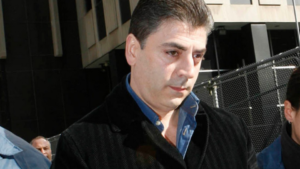
The Mob hit that wasn’t
Police suspect Gambino boss Frank Cali killed by ‘Dumbfella’ construction worker he considered unsuitable to date niece

It could have been a classic “Mob rub-out,” a new case for the FBI’s Criminal Investigations Division and the U.S. Attorney’s Office. That’s what Mob analysts and anonymous cops quoted in the news media expected. But within a few days of the March 13 shooting death of Francesco “Frankie Boy” Cali, reputed boss of New York’s Gambino crime family, the FBI withdrew from the investigation, the cops changed their tune and reporters stopped calling gangland talking heads.
Instead of a Mob soldier from a rival family or a professional killer, U.S marshals arrested a troubled Staten Island construction worker, Anthony Comello, who apparently was upset that Cali refused to let him date Cali’s college student niece. Stranger still, Comello not only implicated himself multiple times in the alleged murder, he wrote messages praising President Trump on the palm of his right hand that he displayed for the news media at his first court appearance in New Jersey, where he fled after the shooting. Prosecutors filed murder, assault and weapons charges that he will face when the case is moved to New York where the killing took place.

So, Cali’s demise proved to be merely half a Mob story, half about a troubled young man who, despite claiming he feared for his life before the shooting, police believe decided to take down his intended’s uncle in a lovelorn rage. And what a takedown – Cali died from 10 gunshot wounds from Comello’s 9mm pistol.
With Comello the main suspect in the killing, the story shifted to the suspect’s behavior that night. About 9:15 p.m., Cali, 53, was in his stately home in the Staten Island neighborhood of Todt Hill, having dinner with his family, including, by some reports, the niece at the center of Comello’s obsession. Outside, the 24-year-old Comello rammed his gray GMC Sierra pickup into Cali’s Cadillac Escalade SUV. He then got out, walked to Cali’s porch and rang the doorbell, all recorded on Cali’s surveillance camera. The two spoke briefly, Comello gave Cali the SUV’s license plate that fell off in the collision and Cali casually tossed it into the SUV. The two shook hands, then Comello fired off 12 shots, 10 of which hit Cali, and drove away. Police ran Comello’s fingerprints from the license plate and got a hit, based on prints Comello once pressed to get a rifle permit. Officers arrested him at his family’s home by the Jersey Shore, but they could not locate the alleged murder weapon.
Once in custody, Comello confessed. He claimed he was stoned on pot – or “candy brains” in Mob parlance – during the shooting and feared that Cali held a gun. Police established that Cali was unarmed.
An old-school Mob “handshake hit” it wasn’t. “Dumbfella” read the front page headline in the New York Post, which quoted an unnamed cop declaring Comello “one of the dumbest killers in New York history, if not the United States and the world.” Police also posited that Comello would be a target for violence while in prison among inmates seeking street cred with the Gambinos. Comello didn’t seem too worried as he smirked and flashed the Trump-related messages on his hand during his court hearing.
Cali, while in his early 30s, climbed to acting captain, then to acting boss of the Gambinos (one of the five major New York families) at age 49 in 2015. His crew preyed on trucking and construction businesses. He served 16 months on a 2008 conviction for extorting builders of a NASCAR racetrack to win his crew a trucking contract in 2006. Born in Sicily, Cali while in the United States maintained close ties for many years to the Inzerillo family in Palermo. His widow, Rosaria Inzerillo, is the daughter of Pietro Inzerillo, a Sicilian who, after the Corleone Mafia killed his two brothers, fled Italy for America. Cali also imported some native Sicilians to join his New York crime family.
Much has been made of Cali’s “ghost” status, that is, his care in keeping a low profile. This was in stark contrast to the late Gambino boss John Gotti Sr., who openly welcomed media attention in the 1980s and ’90s. Moments following Cali’s death, the media published reports from both named and anonymous sources speculating about an internal brawl among the Gambinos.

The lead “suspect” in the theory was Gene Gotti, a convicted heroin trafficker and the younger brother of the dead John Gotti Sr.
Gene got 50 years in federal prison in 1989 for his part in a ring that sold millions of dollars worth of heroin. He became a captain in the Gambinos under his brother John in the wake of the assassination of former boss Paul Castellano in 1985. Castellano opposed drug trafficking so much that he imposed a death sentence against Gambino members caught selling. His demise opened up a new lucrative racket for the Gottis.
Federal witness Salvatore “Sammy the Bull” Gravano, John Gotti Sr.’s former underboss, testified that his boss orchestrated the hit on Castellano. Later, federal prosecutors alleged that Gene Gotti also participated directly in the murder conspiracy with brother John, who died in prison in 2002.
With Cali’s death came widespread talk in the media of Gene’s supposed desire to eliminate Cali and take a leadership role in the Gambinos. Gene won release from prison last September, having served 29 years. However, that talk soon fell silent. Gene’s nephew, John Gotti Jr., demanded that the cops who hypothesized about Gene to the media say that they’re sorry for their mistake.
“I wonder if these tremendously insightful law enforcement individuals are going to issue an apology to Gene Gotti,” Gotti Jr. told the New York Post.
The same paper quoted a response from a law enforcement source, who said that any act of contrition ought to come from the Gambinos for their Mob execution victims.
“Tell Junior we will apologize once his family apologizes to the [Paul] Castellano, [Eddie] Lino and [Wilfred] Johnson families, and all the other families whose relatives they killed and got away with. He should stick to the movie business, or whatever he’s doing to pay the bills.”
Mexican smugglers busing migrants to border

Human smugglers in Mexico, in order to make their “customers” from Guatemala more comfortable, are using fast buses that take only days to reach the U.S. border without the dangers migrants seeking asylum typically encounter with other Mexican criminals along the way, according to The Washington Post.
The newspaper, quoting U.S. law enforcement sources, reported that the smugglers sell their direct transit service to families, typically at a cost as high as $7,000 for an adult with one child.
Smugglers using buses pick up the migrants at staging areas in southern Mexico, then speed north on highways and stop “only for food, fuel and bathroom breaks,” say U.S. authorities. The trip to the border, where migrants may turn themselves in to U.S. border agents and apply for entry, may take only 72 hours.
Weary American officials refer to the hugely profitable busing scheme as “The Conveyor Belt,” for the surging numbers of families crossing the border in recent months. In February, more than 40,000 migrants in family groups reached the U.S. border, a 67 percent increase from the month before.
Central American migrants traveling through Mexico often suffer physical abuse and are forced into “debt bondage,” working menial jobs to pay off the smuggling fees charged by cartel groups.
Swedish bank suspected of suspicious transfers
Swedbank, one of the largest banks in Sweden, is suspected of allowing the flow of as much as $10.2 billion in money laundering transactions to Denmark’s Danske Bank in Estonia, according to a Swedish TV report.
Swedish television outlet SVT first reported in February that some of Swedbank’s customers moved $5.8 billion in alleged laundered money from Danske Bank’s branch in Estonia over an eight-year period. Then in March, Swedbank issued the results of an examination of the bank in 2018 that found the actual amount of laundered funds and questionable transactions between the two banks reached $10.2 billion.
Danske bank is under investigation by the U.S. Justice Department and the Securities and Exchange Commission for possible laundering at the Estonia branch. The scandal involving Danske bank started in 2017 when the institution admitted its Estonian branch permitted $226 billion in suspicious money transfers, from 2007 to 2015, much of it originating from Russia.
U.S. Postal Service seeks to curb fentanyl deliveries
The U.S. Postal Service is stepping up inspections of parcels that might include Chinese-made fentanyl and fentanyl precursors, as international seizures of the drug in the mails increased by 1,000 percent in 2018, according to reports.
While many of the imports from China of deadly fentanyl, and the precursor ingredients used to make it, enter the United States from Mexico through organized crime channels, the number of packages containing the drug and sent by U.S. mail has been growing since 2014, the investigative news website InsightCrime reported.
Greater cooperation, enhanced investigations and drug-detection procedures by U.S. Postal inspectors and state officials led to a 1,000 percent rise in confiscations of parcels sent by international mail and a 750 percent upsurge in seizures of domestic mails related to fentanyl from 2017 to 2018, The Washington Post reported.
Many of the drugs mailed using the Postal Service are ordered by customers over the “Dark Web,” an anonymous part of the Internet accessible only by encrypted software.
In 2017, Congress passed the Synthetics and Overdose Prevention Act, which directs the use of advanced electronic data, or AED, by the Postal Service and U.S. Customs and Border Protection to detect and prevent fentanyl from entering the country.
The law requires the Postal Service to employ AED to screen 70 percent of inbound international parcels currently, and 100 percent by 2021, to intercept those suspected of containing drugs or other contraband. In 2016, the Postal Service received 600 million parcels compared to 50 million by UPS and other private carriers.
More than 70,000 Americans died from overdosing on fentanyl and other opioids such as heroin in 2017, according to the Centers for Disease Control and Prevention. Overdose deaths from synthetic opioids other than methadone, such as fentanyl, fentanyl analogs, and tramadol, rose 45 percent from 2016 and 2017, the CDC reported.
Feedback or questions? Email blog@themobmuseum.org





